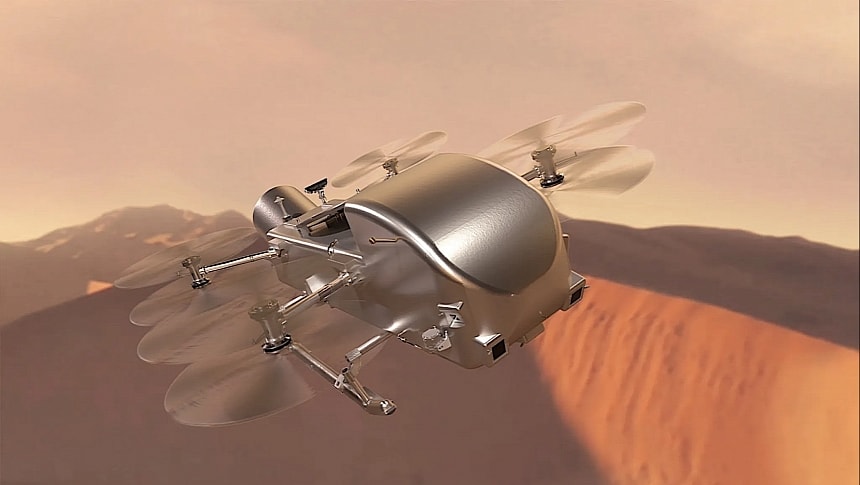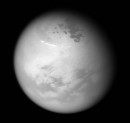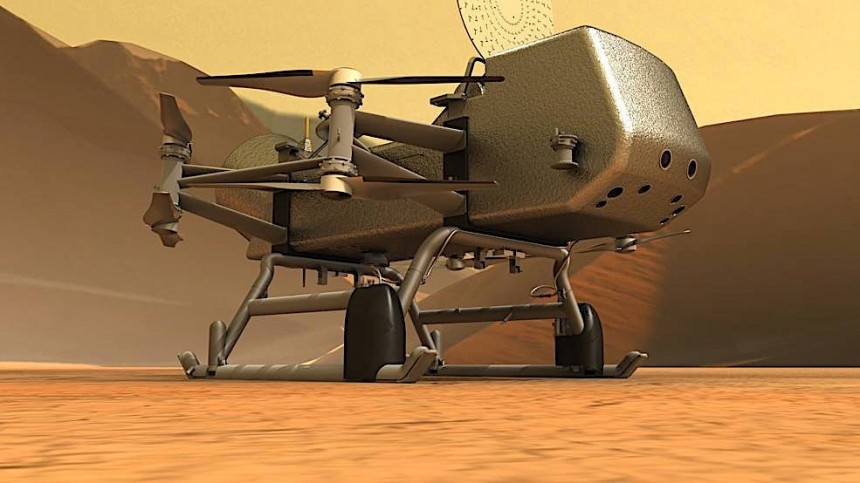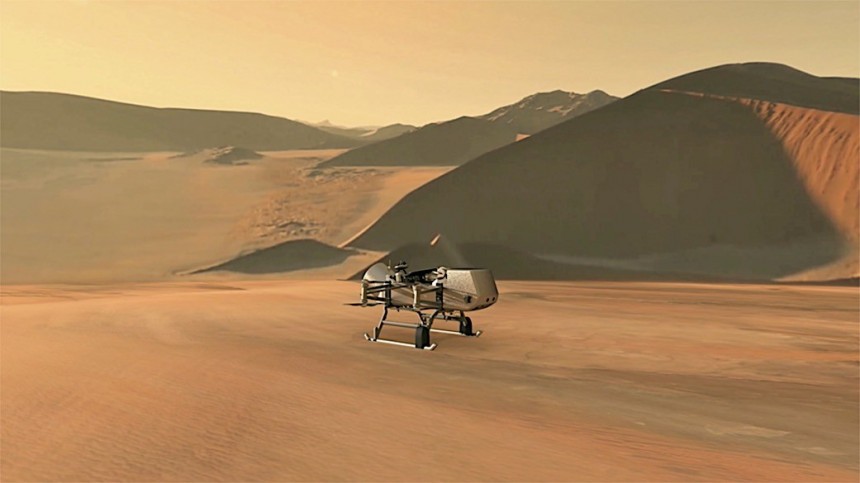In late 2023 American space agency NASA was still looking with hope in its eyes at the president's fiscal year 2025 budget request, hoping that its many exciting missions planned for the next few years will be squeezed in there somehow. One mission, in particular, targeting Saturn's Moon Titan, had rocket scientists particularly concerned.
You all know Saturn. The giant planet is, in essence, the center of its own planetary system, with close to 150 moons of various shapes and sizes spinning around the massive ball of gas.
Many of these moons are not particularly interesting for scientists here on Earth, but one of them has gotten people pretty worked up recently. That would be Titan, of course, a moon so large (it's bigger than Mercury) that it's more like a planet.
But that's not what makes Titan exciting. The place is the only moon we know of in our solar system to have an atmosphere, but also rivers, lakes, and seas. Those would be rivers, lakes, and seas of methane and ethane, and an atmosphere pretty much like Earth's (comprising mostly nitrogen), but with a surface pressure that is 50 percent higher than on our planet.
All of the above (and some other things) make Titan a good candidate for potential monumental discoveries, including insight into prebiotic chemical processes that might have unfolded on Earth as well, eons ago.
Exciting as it may seem, Titan has not been properly studied by a purpose-built American spacecraft until now. Sure, other missions like the Pioneer 11 and the two Voyagers did pass by it, and there was even a probe called Huygens that was dropped onto its surface by the Europeans in 2005.
But what NASA plans now that the president's fiscal year 2025 budget request has been released is a lot bigger than any of those.
What NASA plans is called Dragonfly, and by all intents and purposes, it's a rotorcraft drone that should become the world's first airborne vehicle to be used for science purposes on another world – that's because what Ingenuity did over on Mars can't really be called science.
The exact specifications of the octocopter are not known at the moment, and we don't even have details on a potential landing site yet, although a region of the moon that appears from Earth as a dark spot (and called Shangri-La) looks like the main candidate. But we do know how it's supposed to operate.
Delivered to Titan by means of a yet unspecified spacecraft, the Dragonfly will land in an area of interest, conduct science, and then lift off in search of another place worth studying and land there as well. The drone will do this repeatedly, kind of hopping from place to place.
This approach to planetary exploration has a number of advantages over the rovers currently being used, the most important of them being, of course the distance a flying drone can cover (up to 108 miles/175 km in this case), the speed at which it can get stuff done, and the amount of science it can conduct.
NASA first made the Dragonfly mission public in 2019, and it was initially planned for launch in 2026. But then the COVID pandemic struck, affecting everything and everyone, and the mission was pushed at the end of last year to 2028. Provided, of course, the budget would have allowed it.
We now know it did allow it, and the space agency officially confirmed the Dragonfly mission to Titan as targeting a 2028 launch and a 2034 arrival date on Saturn's Moon. NASA also confirmed the total lifecycle cost of the mission, which by all intents and purposes is double what planners initially believed: $3.35 billion.
Now that NASA has given the mission the final green light, Dragonfly can move on to final design, actual build, and testing for both the drone and the instruments it will carry. The agency will also look into a "heavy-lift launch vehicle to shorten the mission's cruise phase" that would allow for arrival on the moon in 2034.
Some of you may think $3.35 billion could have very well been used in some other way than on a mission to a place so far away nobody really cares about. For scientists, though, those are pennies spent to get incredible rewards.
First and foremost Dragonfly will confirm whether the surface of the moon is habitable, (something we as a species already consider to be so), which could lead to further missions later on.
Secondly, the drone will study the progression of prebiotic chemistry, and that may give us a better understanding of how things evolved on our planet as well.
Last but not least, the mission will likely confirm or deny the existence of water-based or hydrocarbon-based life on Titan, something that is essentialy everything space exploration as we understand it is all about.
Many of these moons are not particularly interesting for scientists here on Earth, but one of them has gotten people pretty worked up recently. That would be Titan, of course, a moon so large (it's bigger than Mercury) that it's more like a planet.
But that's not what makes Titan exciting. The place is the only moon we know of in our solar system to have an atmosphere, but also rivers, lakes, and seas. Those would be rivers, lakes, and seas of methane and ethane, and an atmosphere pretty much like Earth's (comprising mostly nitrogen), but with a surface pressure that is 50 percent higher than on our planet.
All of the above (and some other things) make Titan a good candidate for potential monumental discoveries, including insight into prebiotic chemical processes that might have unfolded on Earth as well, eons ago.
Exciting as it may seem, Titan has not been properly studied by a purpose-built American spacecraft until now. Sure, other missions like the Pioneer 11 and the two Voyagers did pass by it, and there was even a probe called Huygens that was dropped onto its surface by the Europeans in 2005.
What NASA plans is called Dragonfly, and by all intents and purposes, it's a rotorcraft drone that should become the world's first airborne vehicle to be used for science purposes on another world – that's because what Ingenuity did over on Mars can't really be called science.
The exact specifications of the octocopter are not known at the moment, and we don't even have details on a potential landing site yet, although a region of the moon that appears from Earth as a dark spot (and called Shangri-La) looks like the main candidate. But we do know how it's supposed to operate.
Delivered to Titan by means of a yet unspecified spacecraft, the Dragonfly will land in an area of interest, conduct science, and then lift off in search of another place worth studying and land there as well. The drone will do this repeatedly, kind of hopping from place to place.
This approach to planetary exploration has a number of advantages over the rovers currently being used, the most important of them being, of course the distance a flying drone can cover (up to 108 miles/175 km in this case), the speed at which it can get stuff done, and the amount of science it can conduct.
NASA first made the Dragonfly mission public in 2019, and it was initially planned for launch in 2026. But then the COVID pandemic struck, affecting everything and everyone, and the mission was pushed at the end of last year to 2028. Provided, of course, the budget would have allowed it.
Now that NASA has given the mission the final green light, Dragonfly can move on to final design, actual build, and testing for both the drone and the instruments it will carry. The agency will also look into a "heavy-lift launch vehicle to shorten the mission's cruise phase" that would allow for arrival on the moon in 2034.
Some of you may think $3.35 billion could have very well been used in some other way than on a mission to a place so far away nobody really cares about. For scientists, though, those are pennies spent to get incredible rewards.
First and foremost Dragonfly will confirm whether the surface of the moon is habitable, (something we as a species already consider to be so), which could lead to further missions later on.
Secondly, the drone will study the progression of prebiotic chemistry, and that may give us a better understanding of how things evolved on our planet as well.
Last but not least, the mission will likely confirm or deny the existence of water-based or hydrocarbon-based life on Titan, something that is essentialy everything space exploration as we understand it is all about.








